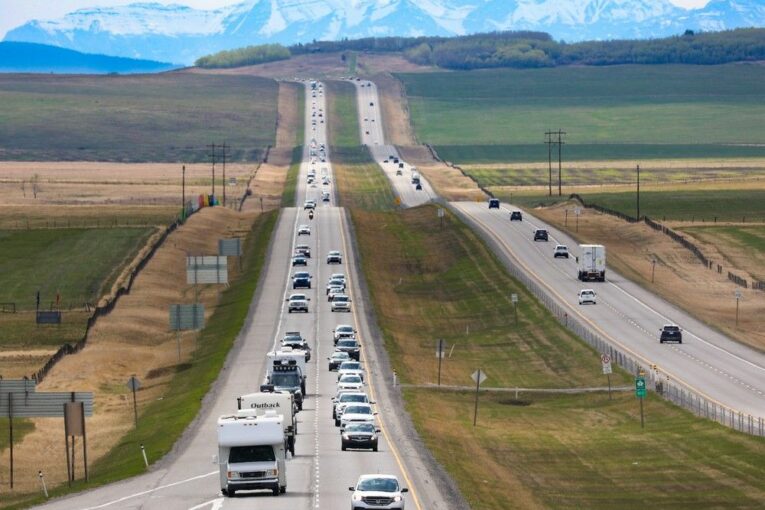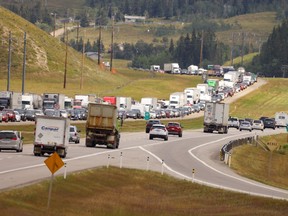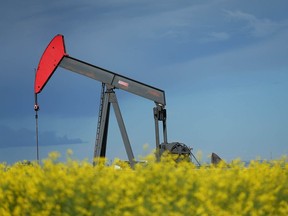
Here are two points of data that don’t have a lot in common, yet help paint the picture of the state of Alberta’s economy today.
New vehicle sales have jumped sharply this year, up nearly 10 per cent through the first half of the year over 2022 levels.
Meanwhile, the sale of Crown land leases to the oil and gas sector is increasing, with the single-biggest sale reported earlier this month since October 2017, according to investment bank Raymond James.
Alberta’s economy, like the rest of the country, is facing pressure from rising interest rates, while inflation continues to boost the bills for key areas such as electricity and groceries.
These two data points, along with continued population growth, strong retail sales and employment increases, indicate the economy in the province is growing.
“The underlying fundamentals of the economy are still relatively strong,” Alberta Central chief economist Charles St-Arnaud said Friday.
“Compared to the rest of the country, it’s clear that Alberta is in a better situation at the moment than other big provinces.”
At auto dealers across the province, sales figures from the first half of the year have increased.
An ATB Financial report indicated that after a challenging 2022, marred by supply chain woes and the impact of rising borrowing costs, the number of new vehicles sold across the province reached 19,292 units in June, almost a seven per cent bump from a year ago.
For the first six months of the year, new vehicle sales in Alberta rose 9.4 per cent, driven by higher demand for trucks and SUVs. Last year, new vehicle sales tumbled by nearly eight per cent in Canada and Alberta, it noted.
“It signals some confidence in the economy and consumer sentiment. It reflects a still-healthy labour market here and the number of people that are coming,” said ATB chief economist Mark Parsons.
“It also signals that some of the supply chain challenges, while still an issue, are easing somewhat.”

Coming out of the pandemic, a global shortage of semiconductor chips and manuacturing delays led to limited supplies of new cars and trucks for consumers.
However, the semiconductor situation has largely “faded into the background” and the sector has regained its manufacturing pace, although some uncertainty remains, industry analyst Stephanie Brinley of S&P Global Mobility wrote recently.
Increased vehicle production this year has led to more options available for local consumers.
“It’s definitely getting better,” said Motor Dealers Association of Alberta president Gerald Wood.
“We’re not seeing dealerships with lots that are completely empty, like we have over the past couple of years. There’s still some catch-up to be had.”
While rising interest rates in the past year have pushed up monthly costs for consumers, there are some attractive offers coming from the original equipment manufacturers, said Glenn Smaha, general manager of the Davis Chevrolet GMC Buick dealership in Airdrie.
“2023 is providing us with the opportunity for growth in our volumes,” he said.
“There is pent-up demand. People have kept their cars longer because they couldn’t get something to replace it with. Now that inventory has returned, those people that were maybe holding off because of supply are now back in the market.”
More broadly, retail sales in Alberta in June were up five per cent from a year earlier — leading the country — although the pace has been slowing, noted Parsons.
ATB projects retail sales will likely be flat for the rest of the year, with some of the heat coming off discretionary items to purchase, he added.
Earlier this summer, ATB forecast the provincial economy would grow by 2.4 per cent this year.
With strong energy prices — benchmark West Texas Intermediate crude closed at US$79.83 a barrel on Friday — capital spending by the oilpatch has also been rising.

The sale of Crown drilling rights to energy companies, which topped $3.5 billion more in 2011 during the oilsands boom but plunged to $29 million during the first year of the pandemic, has been ramping up as some producers look to replenish their land inventory.
The $74 million in so-called “bonus bids” from Crown land sales garnered by the province during a sale in early August was the highest amount collected since the fall of 2017, led by a strong interest in the Montney formation, said analyst Jeremy McCrea of Raymond James.
Another sale this week attracted about $10 million and total land sales have reached $308 million this year, almost eclipsing the total raised for all of 2022, according to Raymond James.
“The fact that you’re starting to see some bigger bonuses now shows companies do have very healthy balance sheets,” McCrea said.
Recommended from Editorial
-

Carbon capture gains steam as natural gas power plants face emissions cap
-

Renewables pause in Alberta affecting 118 projects worth $33 billion, think tank says
-

2035 or 2050? A realistic clean electricity goal for Alberta could fall between the two
Across much of the Canadian oil and gas industry during the past five years, companies had enough prospects to meet their drilling needs and weren’t acquiring land.
With higher prices, that dynamic is changing for some companies, said Michael Belenkie, chief executive of Montney producer Advantage Energy.
“There’s been a resurgence in purchases of land in Canada to try and ensure that companies will be able to grow in the coming five to 10 years,” he said.
“I was surprised how much people are paying up … There are some (producers) out there that recognize the continued growth of their companies requires securing high-quality assets in the right areas.”
Chris Varcoe is a Calgary Herald columnist.
You can read more of the news on source
